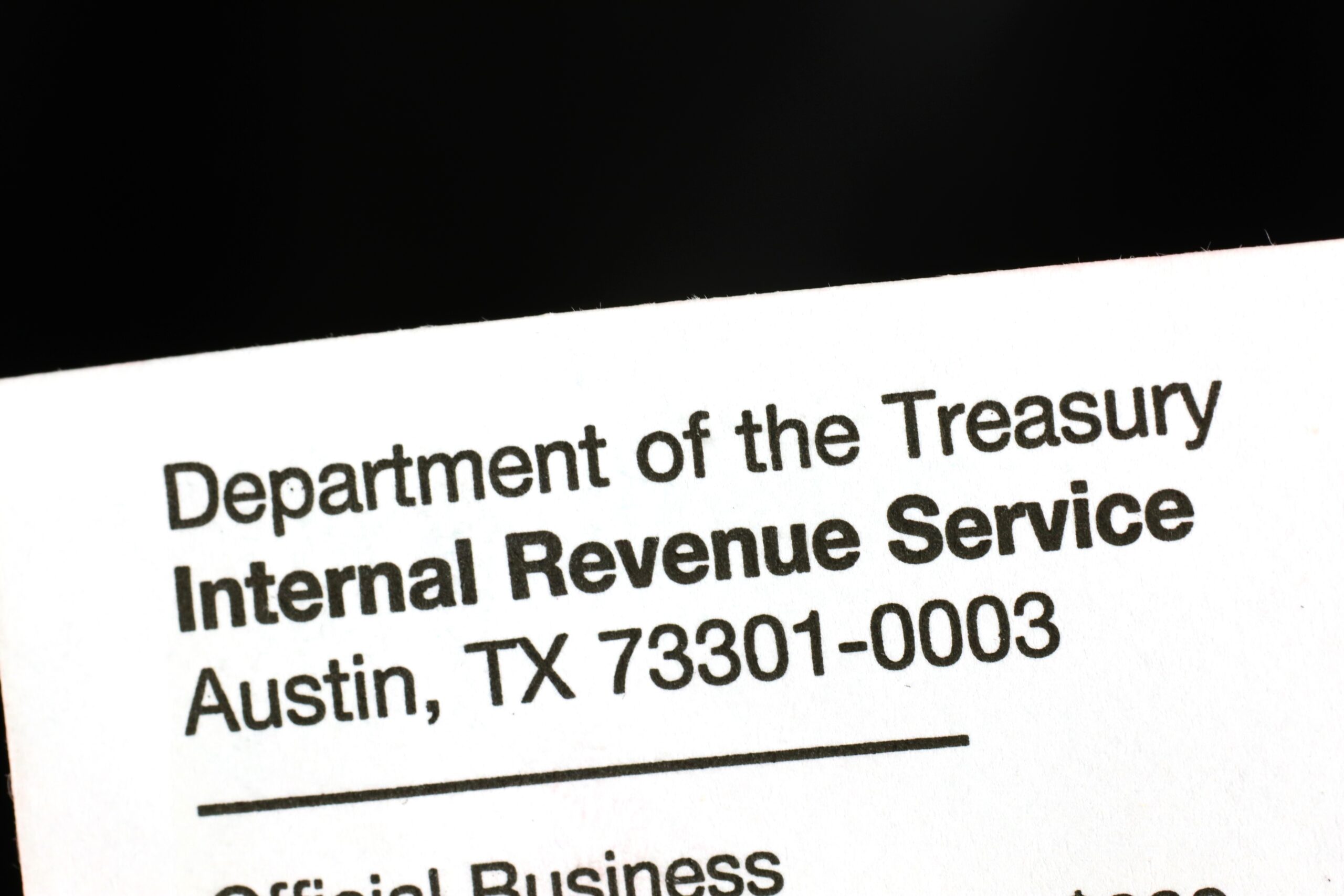What To Know About IRS Letters and Notices
When the IRS needs to ask a question about a taxpayer’s tax return, notify them about a change to their account, or request a payment, it often mails a letter or notice to the taxpayer. Taxpayers should know that the IRS sends millions of these letters and notices to taxpayers for a variety of reasons. Many of these letters and notices can be dealt with simply, without having to call or visit an IRS office.
The IRS sends notices and letters for the following reasons:
- You have a balance due.
- You are due a larger or smaller refund.
- We have a question about your tax return.
- We need to verify your identity.
- We need additional information.
- We changed your return.
- We need to notify you of delays in processing your return.
Your notice or letter will explain the reason for the contact and give you instructions on how to handle the issue. If your notice or letter requires a response by a specific date, there are two main reasons you’ll want to comply:
- To minimize additional interest and penalty charges.
- To preserve your appeal rights if you don’t agree.
Read the Notice Carefully
Most IRS letters and notices are about federal tax returns or tax accounts. Each notice or letter deals with a specific issue and includes specific instructions on what to do and it is important that you read it carefully. A notice may reference changes to a taxpayer’s account, taxes owed, a payment request or a specific issue on a tax return. Taking timely action could minimize additional interest and penalty charges as noted above.
If a letter is about a changed or corrected tax return, the taxpayer should review the information and compare it with the original return. If the taxpayer agrees, they should make notes about the corrections on their personal copy of the tax return and keep it for their records.
When to Take Action
Typically, a taxpayer will only need to take action or contact the IRS if they don’t agree with the information, if the IRS requested additional information, or if they have a balance due. The IRS and authorized private debt collection agencies do send letters by mail. Most of the time, all the taxpayer needs to do is read the letter carefully and take the appropriate action or submit a payment. There is generally no need to reply to a notice or call the IRS unless specifically told to do so.
If a taxpayer does need to call the IRS, they should use the number in the upper right-hand corner of the notice and have a copy of their tax return and letter.
Taxpayers should keep notices or letters they receive from the IRS. These include adjustment notices when an action is taken on the taxpayer’s account. Taxpayers should keep records for three years from the date they filed the tax return.
Watch Out for Scams
IRS notices and letters are sent by mail. The IRS does not correspond by email, phone, or social media about taxpayer accounts or tax returns. You can find the notice (CP) or letter (LTR) number on either the top or the bottom right-hand corner of your correspondence. If you search the IRS website for your notice or letter and it doesn’t return a result – or you believe the notice or letter looks suspicious report it on the Report Phishing page on IRS.gov. Taxpayers who are unsure whether they owe money to the IRS can view their tax account information on IRS.gov.
Help is Just a Phone Call Away
Receiving mail from the IRS is usually not a cause for panic, but it should not be ignored either. If you have any questions or concerns about an IRS letter or notice that you’ve received, don’t hesitate to contact the office.
Understanding Marginal vs. Effective Tax Rates
Understanding marginal and effective tax rates is important for tax planning purposes; however, many taxpayers don’t fully understand the differences. Let’s take a closer look:
Marginal Tax Rate
The United States has a progressive tax system. The more money you earn, the higher your tax rate is and the more taxes you pay to the IRS. In 2022, there are seven tax brackets ranging from 10% to 37%. If you earn $35,000 a year as a single filer, you are in the 12% tax bracket. If you make $550,000 a year as a single filer, you are in the 37% tax bracket. These brackets represent the percentage of taxes you pay based on your taxable income and are referred to as marginal tax rates. When someone says they are in the 35% tax bracket, this is typically what they are referring to – and this is where the confusion begins.
For many taxpayers, their income is the same as their earnings from wages; however, taxpayers should note that income from capital gains may be taxed differently. Short-term capital gains are generally taxed as ordinary income subject to the seven tax brackets mentioned above. Long-term capital gains, however, are taxed at 0%, 15%, and 20%.
Due to the way the tax code is set up and because marginal tax rates apply to each additional level of income above your tax bracket’s income limit, it is not as straightforward as it seems. If you earn $100,000 and are in the 24% tax bracket, it doesn’t mean that you pay a 24% tax on your earned income (0.24 x $100,000 = $24,000).
To illustrate how this works, let’s look at the following example for a single taxpayer earning $100,000 of annual income in 2022 (i.e., filing a tax return in April 2023). The amount of tax owed breaks down as follows:
- 10% Bracket: ($10,275 – $0) x 10% = $1027.50
- 12% Bracket: ($41,775 – $10,275) x 12% = $3,780.00
- 22% Bracket: ($89,075 – $41,775) x 22% = $10,406.00
- 24% Bracket: ($100,000 – $89,075) x 24% = $2,622.00
In the example above, the marginal tax rate (tax bracket) on $100,000 of income is 24%, but the effective tax rate is closer to 18% ($17,835.50/$100,000) – without taking any deduction that reduce taxable income.
Effective Tax Rate
The effective tax rate is the actual amount of federal income taxes paid on a taxpayer’s taxable income and more accurately represents the amount of tax most people pay. The effective tax rate does not include state taxes and local taxes, FICA taxes, or self-employment tax.
Many taxpayers take advantage of tax credits and deductions that reduce taxable income, such as the standard deduction, tax-deductible contributions to a retirement or pension plan, health savings account, tax credits for dependent children, and charitable contributions.
Calculating your effective tax rate is relatively simple: Divide your total tax liability by your gross (before tax) annual income. For example, if you made $100,000 (single filer), took the standard deduction of $12,950 in 2022, reducing your income to $87,050, and paid $14,768.00 in tax, the effective tax rate is closer to 15 percent even though you are in the “24%” tax bracket.
Questions?
If you feel like too much of your hard-earned money goes straight to the IRS instead of your bank account, please call the office to learn more about tax planning strategies that could save you money.
Cash Management Tips for Small Businesses
Cash flow is the lifeblood of every small business but many business owners underestimate just how vital managing cash flow is to their business’s success. In fact, a healthy cash flow is more important than your business’s ability to deliver its goods and services.
While that might seem counterintuitive, consider this: if you fail to satisfy a customer and lose that customer’s business, you can always work harder to please the next customer. If you fail to have enough cash to pay your suppliers, creditors, or employees, you are out of business.
What is Cash Flow?
Cash flow, simply defined, is the movement of money in and out of your business; these movements are called inflow and outflow. Inflows for your business primarily come from the sale of goods or services to your customers but keep in mind that inflow only occurs when you make a cash sale or collect on receivables. It is the cash that counts! Other examples of cash inflows are borrowed funds, income derived from sales of assets, and investment income from interest.
Outflows for your business are generally the result of paying expenses. Examples of cash outflows include paying employee wages, purchasing inventory or raw materials, purchasing fixed assets, operating costs, paying back loans, and paying taxes.
A tax and accounting professional is the best person to help you learn how your cash flow statement works. He or she can prepare your cash flow statement and explain where the numbers come from. If you need help, don’t hesitate to call.
Cash Flow versus Profit
While they might seem similar, profit and cash flow are two entirely different concepts, each with entirely different results. The concept of profit is somewhat broad and only looks at income and expenses over a certain period, say a fiscal quarter. Profit is a useful figure for calculating your taxes and reporting to the IRS.
Cash flow, on the other hand, is a more dynamic tool focusing on the day-to-day operations of a business owner. It is concerned with the movement of money in and out of a business. But more important, it is concerned with the times at which the movement of the money takes place.
In theory, even profitable companies can go bankrupt. It would take a lot of negligence and total disregard for cash flow, but it is possible. Consider how the difference between profit and cash flow relate to your business.
Example: If your retail business bought a $1,000 item and turned around to sell it for $2,000, then you have made a $1,000 profit. But what if the buyer of the item is slow to pay his or her bill, and six months pass before you collect on the account? Your retail business may still show a profit, but what about the bills it has to pay during that six-month period? You may not have the cash to pay the bills despite the profits you earned on the sale. Furthermore, this cash flow gap may cause you to miss other profit opportunities, damage your credit rating, and force you to take out loans and create debt. If this mistake is repeated enough times, you may go bankrupt.
Analyzing your Cash Flow
The sooner you learn how to manage your cash flow, the better your chances of survival. Furthermore, you will be able to protect your company’s short-term reputation as well as position it for long-term success.
The first step toward taking control of your company’s cash flow is to analyze the components that affect the timing of your cash inflows and outflows. A thorough analysis of these components will reveal problem areas that lead to cash flow gaps in your business. Narrowing, or even closing, these gaps is the key to cash flow management.
Some of the most important components to examine are:
- Accounts receivable. Accounts receivable represent sales that have not yet been collected in the form of cash. An accounts receivable balance sheet is created when you sell something to a customer in return for his or her promise to pay at a later date. The longer it takes for your customers to pay on their accounts, the more negative the effect on your cash flow.
- Credit terms. Credit terms are the time limits you set for your customers’ promise to pay for their purchases. Credit terms affect the timing of your cash inflows. A simple way to improve cash flow is to get customers to pay their bills more quickly.
- Credit policy. A credit policy is the blueprint you use when deciding to extend credit to a customer. The correct credit policy – neither too strict nor too generous – is crucial for a healthy cash flow.
- Inventory. Inventory describes the extra merchandise or supplies your business keeps on hand to meet the demands of customers. An excessive amount of inventory hurts your cash flow by using up money that could be used for other cash outflows. Too many business owners buy inventory based on hopes and dreams instead of what they can realistically sell. Keep your inventory as low as possible.
- Accounts payable and cash flow. Accounts payable are amounts you owe to your suppliers that are payable at some point in the near future – “near” meaning 30 to 90 days. Without payables and trade credit, you’d have to pay for all goods and services at the time you purchase them. For optimum cash flow management, examine your payables schedule.
Some cash flow gaps are created intentionally. For example, a business may purchase extra inventory to take advantage of quantity discounts, accelerate cash outflows to take advantage of significant trade discounts or spend extra cash to expand its line of business.
For other businesses, cash flow gaps are unavoidable. Take, for example, a company that experiences seasonal fluctuations in its line of business. This business may normally have cash flow gaps during its slow season and then later fill the gaps with cash surpluses from the peak part of its season. Cash flow gaps are often filled by external financing sources. Revolving lines of credit, bank loans, and trade credit are just a few of the external financing options available that you may want to discuss with us.
Monitoring and managing your cash flow is important for the vitality of your business. The first signs of financial woe appear in your cash flow statement, giving you time to recognize a forthcoming problem and plan a strategy to deal with it. Furthermore, with periodic cash flow analysis, you can head off those unpleasant financial glitches by recognizing which aspects of your business have the potential to cause cash flow gaps.
Need Help?
Without adequate funds to cover day-to-day expenses, your business could fail. Why take that chance? If you need help analyzing and managing your cash flow more effectively, please call and speak to a tax professional who can help.
Use These Strategies To Pass on Wealth to Heirs
Individuals with significant assets should take advantage of proven tax strategies such as gifting and direct payments to educational institutions to transfer wealth to heirs tax-free and minimize estate taxes. Rising inflation, a volatile stock market, and relatively low interest rates also provide additional opportunities. Let’s take a look at some of them:
Gifting
The annual gift tax exclusion provides a simple, effective way of cutting estate taxes and shifting income to heirs. For example, in 2022, you can make annual gifts of up to $16,000 ($32,000 for a married couple) to as many donees as you desire. The $16,000 is excluded from the federal gift tax so that you will not incur gift tax liability. Furthermore, each $16,000 you give away during your lifetime reduces your estate for federal estate tax purposes. However, any amounts above this limit will reduce an individual’s federal lifetime exemption and require filing a gift tax return.
Direct Payments
Direct payments for medical or educational purposes indirectly shift income to heirs; however, it only works if the payments are made directly to the qualifying educational institution or medical provider. This strategy allows you to give more than the annual gifting limit of $16,000 per donee. For example, if you’re a grandparent, you can pay tuition directly to your grandchild’s boarding school, college, or university. Room and board, books, supplies, or other nontuition expenses are not covered. Similarly, they can make direct payments to a hospital or medical provider. Medical expenses reimbursed by insurance are not covered, however.
Loans to Family Members
This strategy works by loaning cash to family members at low interest rates, which is then invested with the goal of reaping significant profits down the road. With mid and long-term applicable federal rates (AFR) rates for October 2022, as low as 3.28 and 3.43 percent, respectively, heirs can lock in these rates for many years – three to nine years (mid-term) and nine to more than 20 years (long-term).
Grantor Retained Annuity Trust (GRAT)
Another relatively low-risk strategy is the grantor retained annuity trust (GRAT), where the donor transfers assets to an irrevocable trust and receives an annuity payment back from the trust each year. This strategy enables heirs to profit from their investments long-term if returns are higher than the IRS interest rate. Now that IRS interest rates are so low, this is easier than ever to do. In October 2022, the interest rate used to value certain charitable interests in trusts such as the GRAT is 4.00 percent.
Roth IRA Conversions
Contributions to a traditional IRA are made pre-tax, which means distributions are considered taxable income; however, the tax is paid upfront with a Roth IRA, and distributions are completely exempt from income tax. This feature makes converting a traditional IRA to Roth IRA and rolling it over to an heir an attractive option, especially during a financial crisis. The conversion is treated as a rollover where the trustee of the traditional IRA is directed to transfer an amount from the traditional IRA to the trustee of the Roth IRA. The account owner pays income tax on the amount rolled over in the year the account is converted, which allows the account to accumulate assets tax-free and future distributions are tax-free.
To learn more about these and other tax strategies related to wealth management, please call the office and speak to a tax professional who can assist you.
Lending Money to a Friend? It Pays To Plan Ahead
Lending money to a cash-strapped friend or family member is a noble and generous offer that just might make a difference. But before you hand over the cash, you need to plan ahead to avoid tax complications for yourself down the road.
Take a look at this example: Let’s say you decide to loan $15,000 to your daughter who’s been out of work for over a year and is having difficulty keeping up with the mortgage payments on her condo. While you may be tempted to charge an interest rate of zero percent, you should resist the temptation.
Here’s why:
When you make an interest-free loan to someone, you will be subject to “below-market interest rules.” IRS rules state that you need to calculate imaginary interest payments from the borrower. These imaginary interest payments are then payable to you, and you will need to pay taxes on these interest payments when you file a tax return. To complicate matters further, if the imaginary interest payments exceed $16,000 for the year, there may be adverse gift and estate tax consequences.
Exception: The IRS lets you ignore the rules for small loans ($10,000 or less), as long as the aggregate loan amounts to a single borrower are less than $10,000, and the borrower doesn’t use the loan proceeds to buy or carry income-producing assets.
As was mentioned above, if you don’t charge any interest, or charge interest that is below market rate (more on this below), then the IRS might consider your loan a gift, especially if there is no formal documentation (i.e. written agreement with payment schedule), and you go to make a nonbusiness bad debt deduction if the borrower defaults on the loan or the IRS decides to audit you and decides your loan is really a gift.
Formal documentation generally refers to a written promissory note that includes the interest rate, a repayment schedule showing dates and amounts for all principal and interest, and security or collateral for the loan, such as a residence (see below). Make sure that all parties sign the note so that it’s legally binding.
As long as you charge an interest rate that is at least equal to the applicable federal rate (AFR) approved by the Internal Revenue Service, you can avoid tax complications and unfavorable tax consequences.
AFRs for term loans that is, loans with a defined repayment schedule, are updated monthly by the IRS and published in the IRS Bulletin. AFRs are based on the bond market, which changes frequently. For term loans, use the AFR published in the same month that you make the loan. The AFR is a fixed rate for the duration of the loan.
Any interest income that you make from the term loan is included on your Form 1040. In general, the borrower, who in this example is your daughter, cannot deduct interest paid, but there is one exception: if the loan is secured by her home, then the interest can be deducted as qualified residence interest–as long as the promissory note for the loan was secured by the residence.
If you have any questions about the tax implications of loaning a friend or family member money, don’t hesitate to call.
Business-related Travel Deductions
Business travel deductions are available when employees travel away from their tax home or principal place of work for business reasons. With inflation on the rise, business travel is more costly than ever. Hotel bills, airfare or train tickets, cab fares, and public transportation can all add up fast.
The good news is that business travelers may be able to off-set some of those costs by claiming business travel deductions when they file their taxes. Let’s take a look at a few details that every business traveler should know about:
- The travel period must be substantially longer than an ordinary day’s work and a need for sleep or rest to meet the demands of the work while away.
- Travel expenses must be ordinary and necessary. They can’t be lavish, extravagant, or for personal purposes.
- Employers can deduct travel expenses (see below) paid or incurred during a temporary work assignment if the assignment length does not exceed one year.
- Travel expenses for conventions are deductible if attendance benefits your trade or business (you can’t deduct the travel expenses for your family). You can’t deduct the expenses if the convention is for investment, political, social, or other purposes unrelated to your trade or business. There are special rules for conventions held outside North America.
Deductible travel expenses while away from home include the costs of:
- Travel by airplane, train, bus, or car between your home and your business destination.
- Fares for taxis or other types of transportation between an airport or train station to a hotel, from a hotel to a work location.
- Shipping of baggage and sample or display material between regular and temporary work locations.
- Using a personally owned car for business, which can include an increase in mileage rates.
- Lodging and non-entertainment-related meals.
- Dry cleaning and laundry.
- Business calls and communication.
- Tips paid for services related to any of these expenses.
- Other similar ordinary and necessary expenses related to business travel.
Self-employed or farmers with travel deductions
Self-employed individuals can deduct travel expenses on Schedule C (Form 1040), Profit or Loss From Business (Sole Proprietorship). Farmers should use Schedule F (Form 1040), Profit or Loss From Farming.
Travel deductions for the National Guard or military reserves
National Guard or military reserve service members can claim a deduction for unreimbursed travel expenses paid during the performance of their duty.
Recordkeeping
Well-organized records make it easier to prepare a tax return and help provide answers if your return is selected for examination or if you receive an IRS notice. You must keep records, such as receipts, canceled checks, and other documents that support an item of income, a deduction, or a credit appearing on a return.
Questions?
If you have questions about business-related travel deductions, don’t hesitate to call the office.
Tax Deductions for Homeowners
For many people buying a home – whether it’s a fixer-upper in an up and coming neighborhood or that custom home you’ve always dreamed of – is a milestone event. While there is often a steep learning curve associated with buying and owning a home, there are also some perks – at least when it comes to taxes.
The first thing taxpayers should understand is that when it comes to home ownership is how the IRS defines a home as: a house, condominium, cooperative apartment, mobile home, houseboat or house trailer that contains a sleeping space, toilet and cooking facilities. It’s important to note that even if you own several homes, an individual has only one main home at a time. Generally, people own and live in just one home. If so, then that property is your main home.
Most home buyers take out a mortgage loan to buy their home and then make monthly payments to the mortgage holder. This payment may include several costs of owning a home. The only costs the homeowner can deduct are:
- State and local real estate taxes (SALT) – subject to the $10,000 limit
- Home mortgage interest – within the allowed limits
- Mortgage insurance premiums
Taxpayers must file Form 1040, U.S. Individual Income Tax Return or Form 1040-SR, U.S. Income Tax Return for Seniors, and itemize their deductions to deduct home ownership expenses. Taxpayers cannot, however, take the standard deduction if they itemize.
Non-deductible Payments and Expenses
Homeowners can’t deduct any of the following items:
- Insurance, other than mortgage insurance, including fire and comprehensive coverage, and title insurance
- The amount applied to reduce the principal of the mortgage
- Wages you pay for domestic help
- Depreciation
- The cost of utilities, such as gas, electricity, or water
- Most settlement or closing costs
- Forfeited deposits, down payments, or earnest money
- Internet or Wi-Fi system or service
- Homeowners’ association fees, condominium association fees, or common charges
- Home repairs
Mortgage Interest Credit
The mortgage interest credit is meant to help individuals with lower income afford home ownership. Those who qualify can claim the credit each year for part of the home mortgage interest paid.
A homeowner may be eligible for the credit if they were issued a qualified Mortgage Credit Certificate (MCC) from their state or local government. An MCC is issued only for a new mortgage for the purchase of a main home. The MCC will show the certificate credit rate the homeowner will use to figure their credit. It will also show the certified indebtedness amount and only the interest on that amount qualifies for the credit.
Homeowners Assistance Fund
The Homeowners Assistance Fund program provides financial assistance to eligible homeowners for paying certain expenses related to their principal residence to prevent mortgage delinquencies, defaults, foreclosures, loss of utilities or home energy services, and also displacements of homeowners experiencing financial hardship after January 21, 2020.
Minister’s or Military Housing Allowance
Ministers and members of the uniformed services who receive a nontaxable housing allowance can still deduct their real estate taxes and home mortgage interest. They don’t have to reduce their deductions based on the allowance.
As always, please contact the office if you have any questions about this important tax topic. Help is just a phone call away.
Closing a Business for Good
If you’re a small business owner who is thinking about closing your business for good, you should be aware that there is more to closing a business than laying off employees, selling office furniture, and closing the doors – you must also take certain actions as required by the IRS to fulfill your tax obligations. For example, if you have employees, you must file final employment tax returns as well as make final federal tax deposits of these taxes.
You must also file an annual tax return for the year you go out of business. You also need to attach a statement to your return listing the name and address of the person that keeps the payroll records (this could be you or another person). If you are disposing of business property, exchanging like-kind property, and/or changing the form of your business, you must file a return to report these actions.
Depending on your type of business structure, you may need to take the some or all of the following steps:
- File final federal tax deposits
- File final quarterly or annual employment tax form (Forms 94x)
- Issue final wage and withholding information to employees (Form W-2, Wage and Tax Statement
- Report information from W-2s issued (Form W-3, Transmittal of Income and Tax Statements)
- File final tip income and allocated tips information return (Form 8027, Employer’s Annual Information Return of Tip Income and Allocated Tips)
- Report capital gains or losses
- Report partner’s/shareholder’s shares (Schedules K-1)
- File final employee pension/benefit plan
- Issue payment information to sub-contractors (Form 1099-MISC, Miscellaneous Income)
- Report information from 1099s issued Form 1096, Annual Summary and Transmittal of U.S. Information Returns)
- Report corporate dissolution or liquidation
- Consider allowing S corporation election to terminate
- Report business asset sales
- Report the sale or exchange of property used in your trade or business.
If you find yourself in the difficult position of having to close your business and have more questions than answers, help is just a phone call away.
Federal Tax Obligations During Chapter 13 Bankruptcy
The most common type of bankruptcy for individuals is Chapter 13, which allows individuals and small business owners in financial difficulty to repay their creditors. Often, it is a last resort for wage earners (individuals and those filing jointly as spouses), the self-employed and sole proprietor businesses to get out of their debts. While the overall bankruptcy rate has been dropping in recent years, Chapter 13 appears to be increasing, according to the US Courts. If you’re considering filing for Chapter 13, here’s what you should know about federal tax obligations:
First, taxpayers must file all required tax returns for tax periods ending within four years of their bankruptcy filing. During a bankruptcy taxpayers must continue to file, or get an extension of time to file, all required returns. Failure to file returns and pay current taxes during a bankruptcy may result in a case being dismissed, converted to a liquidating bankruptcy chapter 7, or the chapter 13 plan may not be confirmed. Furthermore, during a bankruptcy case taxpayers should pay all current taxes as they come due.
What Else You Should Know
If one of the reasons a taxpayer is filing bankruptcy is overdue federal tax debts, they may need to increase their withholding or their estimated tax payments. The Tax Withholding Estimator can help people determine the proper withholding. The IRS.gov Estimated Taxes page has more information on estimated taxes.
If the IRS is listed as a creditor in their bankruptcy, the IRS will receive electronic notice about their case from the U.S. Bankruptcy Courts. People can check by calling the IRS’ Centralized Insolvency Operation at 800-973-0424 and giving them the bankruptcy case number.
People can still receive tax refunds while in bankruptcy. However, refunds may be subject to delay or used to pay down their tax debts. Taxpayers can see if their refund has been delayed or offset against their tax debts by going to the Where’s My Refund tool or by contacting the Centralized Insolvency Operations Unit.
Other Types of Bankruptcy
Partnerships and corporations file bankruptcy under Chapter 7 or Chapter 11 of the bankruptcy code. Individuals may also file under Chapter 7 or Chapter 11. Other types of bankruptcy include Chapters 9, 12 and 15. Cases under these chapters of the bankruptcy code involve municipalities, family farmers and fisherman, and international cases.
Please call if you have any questions about federal filing obligations and Chapter 13 bankruptcy.
Early Withdrawals from Retirement Plans
Many people find themselves in situations where they need to withdraw money from their retirement plan earlier than planned. Doing so, however, can trigger an additional tax on top of any income tax taxpayers may have to pay. Here are five things taxpayers should know about early withdrawals from retirement plans:
1. Early Withdrawal.An early withdrawal normally is taking cash out of a retirement plan before the taxpayer is 59 1/2 years old.
2. Paying Additional Tax.If a taxpayer took an early withdrawal from a plan last year, they must report it to the IRS. They may have to pay income tax on the amount taken out. If it was an early withdrawal, they might have to pay an additional 10 percent tax.
3. Nontaxable Withdrawals.The additional 10 percent tax does not apply to nontaxable withdrawals. These include withdrawals of contributions that taxpayers paid tax on before they put them into the plan. A rollover is a form of nontaxable withdrawal. A rollover occurs when people take cash or other assets from one plan and put the money in another plan. They normally have 60 days to complete a rollover to make it tax-free.
4. Exceptions.There are many exceptions to the additional 10 percent tax. Some of the rules for retirement plans are different from the rules for IRAs.
5. Form 5329.If someone took an early withdrawal last year, they may have to file Form 5329, Additional Taxes on Qualified Plans (Including IRAs) and Other Tax-Favored Accounts, with their federal tax return.
Please call if you have any questions about early withdrawals or filing Form 5329.
Dealing with Payments and Deposits in QuickBooks
If you’re still doing your accounting manually, depositing checks and cash that come in from customers takes a lot of work. You probably wait until you have several payments to deposit to minimize your trips to the bank. When you’re ready, you have to fill out a deposit slip and calculate a total, though you’ve probably already recorded the transactions elsewhere in your bookkeeping system. You must store the transaction receipt from the bank in a safe place, probably in a folder with your documentation from the deposit.
QuickBooks simplifies the process of recording deposits. If you’re using QuickBooks Payments, deposits get processed automatically. If you’re not, you can use QuickBooks tools that help you prepare deposits by selecting payments you’ve already recorded and getting them ready to present to the bank. This is another example of how the software helps you avoid doing unnecessary, tedious bookkeeping chores.
Here’s how it works:
How Do You Record a Payment In QuickBooks?
When you receive cash or a check from a customer, QuickBooks allows you to record it in the Receive Payments window. You can select the customer and enter the amount in the fields provided. You can also select the type of payment (cash, check, credit/debit card, or e-check). If the customer has outstanding invoices, you’ll see them listed at the bottom of the window. Double-check your work and save the transaction.
You can add or delete payment methods so you’ll only see the ones you offer. Open the Lists menu and click Customer & Vendor Profile Lists | Payment Method List. Open the Payment Method menu in the lower right to add a new one or edit or delete existing ones.

Figure 1: You can record customer payments in this QuickBooks window.
Where Do the Payments Go?
Unless you have instructed QuickBooks to do otherwise, payments you record in the software automatically go in an account called Undeposited Funds, where they remain until you deposit them.
There is a way to specify a different account for your payments. You can also set up QuickBooks so you’re able to choose a different account for individual transactions. We don’t recommend that you try this on your own. Let us explain how to do it and how QuickBooks will be affected.
To see your Undeposited Funds account, click the Chart of Accounts icon on the home page or open the Company menu and select Chart of Accounts. Scroll down a bit until you see Undeposited Funds. Double click it to see all of the transactions contained there, but don’t alter them. This account is just a holding place for transactions in transition.
How Do You Process a Deposit?
When you’re ready to take cash and checks to the bank and you have your deposit slip ready, click Record Deposits on the home page. A window like this will open:

Figure 2: You’ll select the payments you want to deposit in this window.
Make any changes you want to the options under Select View at the top of the window, and click in front of any payments you want to include in the deposit to create checkmarks. Compare the Payment Subtotal to your deposit slip to make sure they match. When you’re satisfied, click OK.
In the upper left corner of the Make Deposits window that opens, make sure the Deposit To window is showing the account where the funds should go and that the Date of deposit is correct. Add a Memo if you’d like. If you want to receive cash back, select the destination account and enter the amount in the lower left corner of the window. When everything is correct, save the deposit. Your account register will now reflect this transaction.
A quick way to look at an account register is to open the Banking menu and select Use Register. Choose the account in the window that opens.
Help Is Just a Phone Call Away
Deposits are another QuickBooks feature that looks deceptively simple. That is, the mechanics aren’t complicated, but you definitely don’t want to be making any mistakes here. If you need assistance, please call. It’s a lot easier to learn how to use this tool up front than to go in and try to untangle errors.
A Warning from Intuit: In case you missed the email, Intuit sent out warnings to users about a recent increase in phishing scams. Hackers who want to steal your information send very official-looking emails (logo and everything) that imply they’re from Intuit. They suggest there might be a problem with your account and ask you to click a link to verify/supply some personal information. The company does not send emails like this. We recommend you never click a link in an email unless you know it’s coming and it’s from a trusted source.
Tax Due Dates for October 2022
October 17
Individuals – If you have an automatic 6-month extension to file your income tax return for 2021, file Form 1040 and pay any tax, interest, and penalties due.
Corporations – File a 2021 calendar year income tax return (Form 1120) and pay any tax, interest, and penalties due. This due date applies only if you timely requested an automatic 6-month extension.
Employers – Nonpayroll withholding. If the monthly deposit rule applies, deposit the tax for payments in September.
Employers – Social Security, Medicare, and withheld income tax. If the monthly deposit rule applies, deposit the tax for payments in September.
October 31
Employers – Social Security, Medicare, and withheld income tax. File form 941 for the third quarter of 2022. Deposit any undeposited tax. (If your tax liability is less than $2,500, you can pay it in full with a timely filed return.) If you deposited the tax for the quarter in full and on time, you have until November 10 to file the return.
Certain Small Employers – Deposit any undeposited tax if your tax liability is $2,500 or more for 2022 but less than $2,500 for the third quarter.
Employers – Federal Unemployment Tax. Deposit the tax owed through October if more than $500.
Any accounting, business or tax advice contained in this communication, including attachments and enclosures, is not intended as a thorough, in-depth analysis of specific issues, nor a substitute for a formal opinion, nor is it sufficient to avoid tax-related penalties. If desired, we would be pleased to perform the requisite research and provide you with a detailed written analysis. Such an engagement may be the subject of a separate engagement letter that would define the scope and limits of the desired consultation services.
































